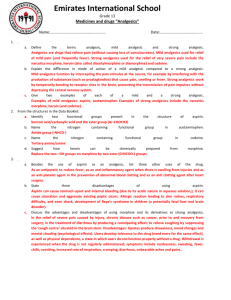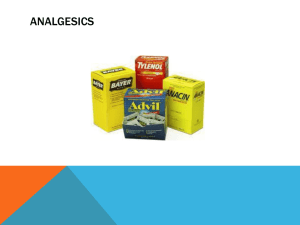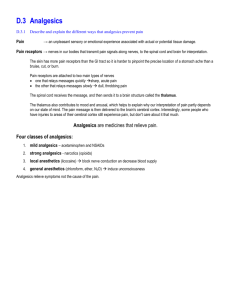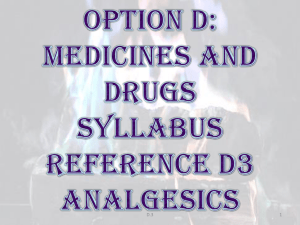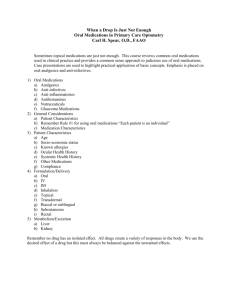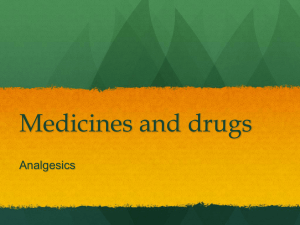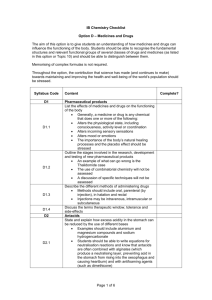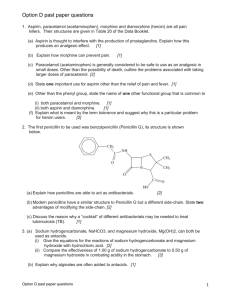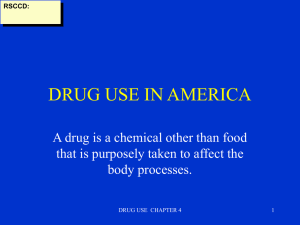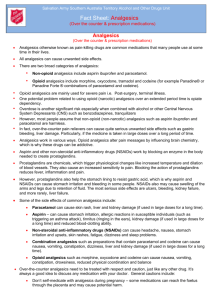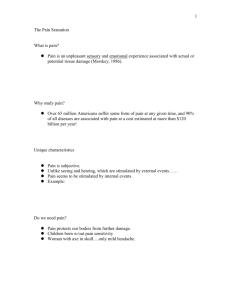Analgesics - Worksheet
advertisement
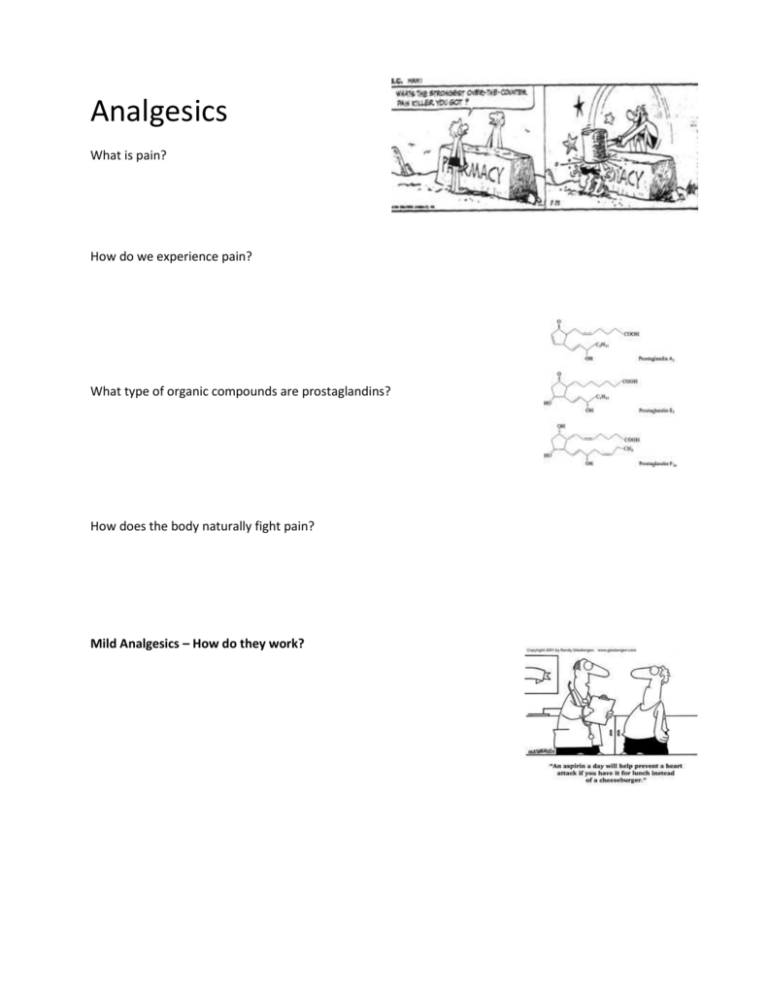
Analgesics What is pain? How do we experience pain? What type of organic compounds are prostaglandins? How does the body naturally fight pain? Mild Analgesics – How do they work? Aspirin Highlight and name the functional groups of each molecule. Write down the desired physiological effects Write down the side effects What is the effect of drinking alcohol whilst using this drug? What possible allergic reactions may occur? Who is the drug suitable for? Re-draw the paracetamol molecule to show the functional groups at the bottom clearly. Paracetamol Ibuprofen Strong Analgesics – How do they work?? Codeine Highlight and name the functional groups Where does the drug come from? List the functional groups present. What are its therapeutic uses? What are its side effects? Morphine Heroin (diamorphine) Sample Questions 1. (i) State what is meant by the term analgesic. Explain the difference in the mode of action of mild and strong analgesics. ………………………………………………………………………………………….. ………………………………………………………………………………………….. ………………………………………………………………………………………….. ………………………………………………………………………………………….. ………………………………………………………………………………………….. ………………………………………………………………………………………….. (3) (ii) State the general names of the two functional groups attached to the benzene ring in a molecule of aspirin. ………………………………………………………………………………………….. (2) (iii) The use of aspirin can have beneficial effects for the user, but can also produce some unwanted side effects. State one beneficial effect (other than its analgesic action) and one unwanted side effect. ………………………………………………………………………………………….. ………………………………………………………………………………………….. ………………………………………………………………………………………….. (2) (Total 7 marks) 2. Morphine is a naturally occurring analgesic that can be converted into codeine. (i) Calculate the difference in relative formula mass between morphine and codeine. ………………………………………………………………………………………….. (1) (ii) Explain what is meant by developing tolerance towards codeine and state why this is dangerous. ………………………………………………………………………………………….. ………………………………………………………………………………………….. (2) (Total 3 marks) 3. Ibuprofen is an analgesic with the following structure: O C CH 2 H 3C CH OH CH CH 3 CH 3 (a) Identify the chiral carbon atom(s) in the structure of ibuprofen using an asterisk (*). (1) (b) Describe how chiral auxiliaries can be used to synthesize only the desired enantiomeric form of a drug from a non-chiral starting compound. Explain why it is important to use only the desired enantiomeric form of a drug and state an example of what can happen if a racemic mixture is used. ...................................................................................................................................... ...................................................................................................................................... ...................................................................................................................................... ...................................................................................................................................... (5) (Total 6 marks) 4. The structures of some analgesics are shown in Table 21 of the Data Booklet. Refer to this table when answering parts (b) and (c) of this question. (a) Explain the difference in the method of action of mild analgesics and strong analgesics. ..................................................................................................................................... ..................................................................................................................................... ..................................................................................................................................... (2) (b) State the name of the nitrogen-containing functional group in each of the following molecules. Paracetamol ................................................................................................................ Heroin ......................................................................................................................... (2) (c) Naturally-occurring morphine can be converted into synthetic heroin by reaction with ethanoic acid. Identify the group in the morphine molecule that reacts with ethanoic acid, the name of the type of reaction and the other product of the reaction. Group in morphine molecule ....................................................................................... Type of reaction ........................................................................................................... Other product of reaction ............................................................................................. (3) (Total 7 marks) Answers 1. (i) (ii) (iii) a substance that reduces pain; mild analgesics intercept pain at the source/interfere with production of substances that cause pain; strong analgesics bond to receptor sites in the brain/prevent the transmission of pain impulses; carboxylic (acid)/alkanoic (acid); ester; Accept only these names. 3 2 Any one of the following [1]. beneficial effects used to treat mini-strokes; prevents heart attacks/reduces risk of heart attack/thins the blood/ anti-coagulant; relieves symptoms of rheumatological diseases/anti-inflammatory; reduces fever; Any one of the following [1]. side effects stomach bleeding allergic reaction; Reye’s syndrome; hearing loss; tinnitus (ringing in the ears); gastrointestinal irritation (e.g. heartburn, nausea); 2 [7] 2. 3. (i) 14/14.03 (ignore units); 1 (ii) increasing amounts needed to produce same effect; increasing amounts cause damage/death; 2 (a) O * OH 1 (b) a chiral auxiliary is itself an enantiomer; it is bonded to the reacting molecule to create the stereochemical conditions necessary to follow a certain pathway; once the desired enantiomer is formed the auxiliary is removed; different enantiomers may have different biological effects, some of which may be harmful; genetic defects/deformities/other suitable example; 5 [6] 4. (a) mild analgesics intercept pain stimulus at source/OWTTE; strong analgesics interact with receptor sites in the brain/OWTTE; (b) (c) 2 amide; (tertiary) amine Do not accept primary or secondary amine; 2 OH/alcohol/phenol/hydroxyl; esterification/condensation; water/H2O; 3 [7]

